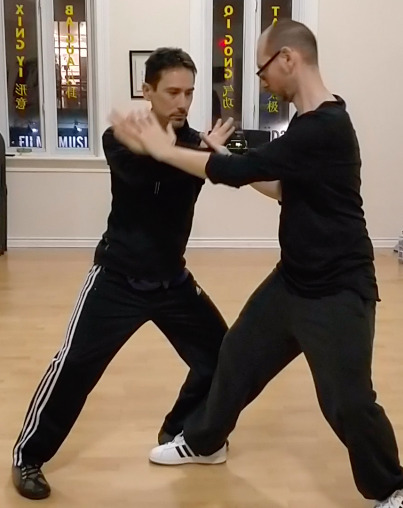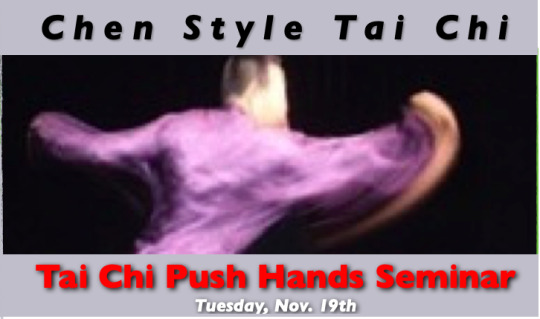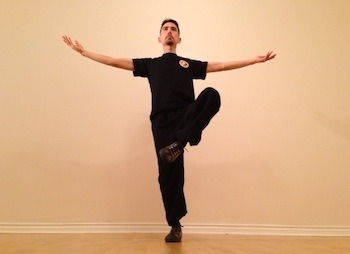Discover the Internal Arts Classes in Qigong (Qi Gong), Taiji (Tai Chi), Xingyi (Hsin i) and Bagua (Pa Kua) in Guelph, Ontario. Learn these traditions in an open, non-competitive environment. Information on the club, class schedules and resources for students can be found in the navigation bar above. I hope the blog entries below provide interesting reading and food for thought for everyone interested in the internal arts.
Don't wanna be here? Send us removal request.
Photo

New Qigong classes for the fall session begin next week! Details at http://eastmountain.ca/zoom.html
0 notes
Photo

To help students continue to practice and learn despite the COVID-19 pandemic, I'm posting lessons on my website. The first set of lessons for Qigong, Taichi, Bagua and Xingyi are now posted!
www.eastmountain.ca/learning.html
0 notes
Text
Classes Cancelled for March
Due to the Corona virus pandemic, classes are cancelled for March, 2020.
Future plans will develop as the situation evolves. All the best and stay well.
2 notes
·
View notes
Photo

Xingyi and Bagua Workshop Summary, January, 2020
Hebei Xingyi Quan In the morning, beginners were taught the five element strikes - wuxing quan:
Pi Quan (Chop)
Zuan Quan (Drill)
Beng Quan (Drive)
Pao Quan (Cannon)
Heng Quan (Crosscut)
These five techniques teach the essence of Xingyi structure and alignment. In addition they teach Xingyi stepping and the generation of Full Body Power. The five techniques teach striking in five directions: down, up, though, outside and inside.
Returning students were taught Ba Shi Quan. This routine combines the Five Element Strikes and some of the Twelve Animals (Horse, Chicken and Sparrowhawk). It teaches agile stepping and refines Full Body Power generation and release. This routine is called Ba Shi because of the combination of techniques found in the sequence. A full discussion of this can be found in Andrea Falk's translation, Di Guoyong on XIngyi Quan, vol.2.
“The rhythm of the eight postures routine is focussed on the power launch of the eight key combinations. At each point of power launch, first store power and then launch it. Power must be full, stable, and complete.” Di Gouyong, “Di Guoyong on XIngyiquan, vol.2, pg 298
The Five Elements Linking Routine (Wuxing Lianhuan Quan) was also covered
youtube
This routine combines the five fundamental strikes and introduces variations in footwork and trains the ability to combine techniques in a smooth continuous manner.
Finally the opening movements of the partner routine, An Shen Pao was taught. A video of these moves for B’s side is posted on Vimeo. It is password protected but students can contact me to view it. This sequence trains coordination of stepping with offensive and defensive techniques.
Jiang and Magui style Bagua The morning covered Jiang style Bagua. The warm up sequence was taught in detail to beginner students.
youtube
Returning students reviewed Changes 1 to 6 and were taught Changes 7 and 8. A very rough run through of these changes is posted on YouTube in an unlisted video.
While training the Changes, keeping the hip joint relaxed and maintaining an unbroken coiling strength throughout the body was emphasized. Extend into the full range of each movement to find the coiling power through the body.
The afternoon was devoted to Magui style Bagua. Beginners were taught Bear posture Circle walking.
Magui Bagua uses a heavy low-basin walk to develop strength from the lower leg up. Key points for this training include:
Keeping the foot parallel to the ground, like rolling a cloth rag;
Full extension of the leg - straightening the knee;
When planting the foot, set into the feet like stepping in the head and tail of a snake; and
Walk from below the knees
A more detailed discussion can be found on Andrea Falk’s Magui Bagua training page.
Four technique drills were also taught:
Tan Zhang (Reaching Palm)
Gai Zhang (Covering Palm)
Chuan Zhang (Spearing Palm)
Zhuang Zhang (Ramming Palm)
youtube
Returning students reviewed the Eight Dragon Changes. A description of these can be found and the Magui Bagua training website.
0 notes
Photo

Studio Open House Classes - January 6th & 8th Visit Stone Lantern Internal Arts in the new year to try a class for free:
Monday, January 6th, Chen Tai Chi at 7pm & 8pm.
Wednesday, January 8th, Qigong at 7pm, and Bagua/Xingyi at 8pm.
0 notes
Photo

Summary of Hands Seminar with Jack Yan
The workshop started with Post Standing practice. This practice builds internal structure - Peng strength. Key pointers included relaxing the hips; creating a rounded arch with the legs and groin, lifting the torso and settling the shoulders; and holding the arms in a rounded posture with the thumbs extended. To build awareness of the Peng strength, the arms can open and close slightly, and then move up and down slightly. Continuing with standing, the hands become level with the lower Dan Tien. Move the arms to open and close, paying attention to sensation in the hands. The sensation should be of a slightly pulling as the arms open and a slight pushing as the arms close. The sensation can develop into a slight pulling followed by expansion when opening and a slight push followed by a drawing together while closing. Train to have body respond to opening & closing automatically.
Peng in this context refers to a structural strength that uses the sinews to hold the body form. This requires certain muscles to hold tension while others to relax and allow free movement. Master Yan recommended routine training while using hand grips to train muscular strength while maintaining relaxed motion.
This was followed by Single Hand Horizontal Circle Training. This was practiced both solo and with a partner. This practice continues to train internal structure/strength and link it with Dan Tien motion. The Single Hand drill also trains Peng and Lu. Be sure the hand does not cross the mid-line and connect the wrist rotation with the body movement. Master Yan also explained that external rotation sends the flow of energy outwards while internal rotation sends the flow of energy inwards. These are the same rotations used with a screwdriver (in your right hand). The Single Hand Rotation can be done in a horizontal circle or in a vertical circle. To link these movements with the body, Master Yan distinguished between two different movements of the Dan Tien - spin and rotation: Spin: involves an equal movement on the left and right sides - the legs move, but the body doesn’t; Rotation: involves a movement where one side is fixed - the body moves but the legs stay fixed. Combined, these two movements create the characteristic Figure 8 movement of the Dan Tien.
There are four Chinese characters which outline the connection between internal power and structure: Jing 精 - Essence Jin 觔- Sinews Jin 劲- Power Jing 经- Channels Together they reference the relationship that our sinews and tendons have with our internal reserves and the relationship that our channels have with our strength and vitality. It also includes the idea that training rotational movements targeting the sinews and channels helps train our internal reserves (Essence) and strength (Power). Master Yan further explained that a rounded posture is important for the activating of the tendons and channels. He contrasted this with lengthening the body in a straight line which doesn’t achieve the same ends.
Double Hands, Fixed Step Push Hands was then practiced with multiple partners. The terms Peng, Lu, Ji & An (Wardoff, Rollback, Squeeze and Press) were explained. Including the close relationship between Peng, Ji & An. These three involve using a positive force, either pushing (Peng), close range hemming in (Ji) or downward pressing (An). While Lu makes use of negative force - taking strength away to re-direct. All four train body positioning used to adjust placement of one’s centre. This was contrasted with Cai, Lei, Zhao & Kao, which train applications: Cai - Pluck: speed and power are applied at the start of the movement; Lei - Rend: speed and power are expressed the the end of the movement; Zhao - Elbow: includes strikes using the bend of the wrist, elbow and knee; and Kao - Bump: close range strikes with the torso. These four were demonstrated but not practiced.
Master Yan also highlighted the “Figure 9” posture of the arms within the Double Hands Push Hands pattern. Allowing one person to train Peng strength with this “Figure 9” posture while the other person trains An - pressing downwards. Also hand placement on either side of the other person’s elbow with Peng and An was used to explain the concept of controlling two points. Tai Chi movements require an alternation between Yin and Yang, having a solid side and an empty side, having a weighted side and an unweighted side. By positioning your opponent between these two sides you are able to respond to and control them.
The evening finished with practice of three applications: Wrist lock from double hand press Wrist lock from opposite side wrist grab Wrist lock from same side shoulder grab All three used joint locks applied to the wrist, from three different starting positions. At the start of the evening, Master Yan described Push Hands as co-operative training to help the person you are working with to further their skill and to help you identify how to improve your own training. While applications focuses on technique as opposed to Tai Chi principles, this same co-operative approach was emphasized.
2 notes
·
View notes
Photo

Deepen your Tai Chi skill through Chen style Push Hands. This hands-on, interactive workshop will introduce the principles & training of this 2-person practice . Prior experience with Tai Chi is recommended. Registration: $80 Tuesday, Nov. 19th, 7:00pm to 9:30pm
1 note
·
View note
Video
youtube
Chen Taiji Tuishou Fundamentals It's very common to overlook what can be learnt from fundamental drills like this one. Single-hand, horizontal circle practice helps to build peng strength, find vertical alignment and loosen the hips. All of these are essential for practicing the routine as well as push hands. Looking closely, you can see times when the movement of my hips and arm are poorly co-ordinated. A smoother rotation in the hips would correct this. Typically this happens when thinking about the movement gets in the way of doing the movement.
3 notes
·
View notes








